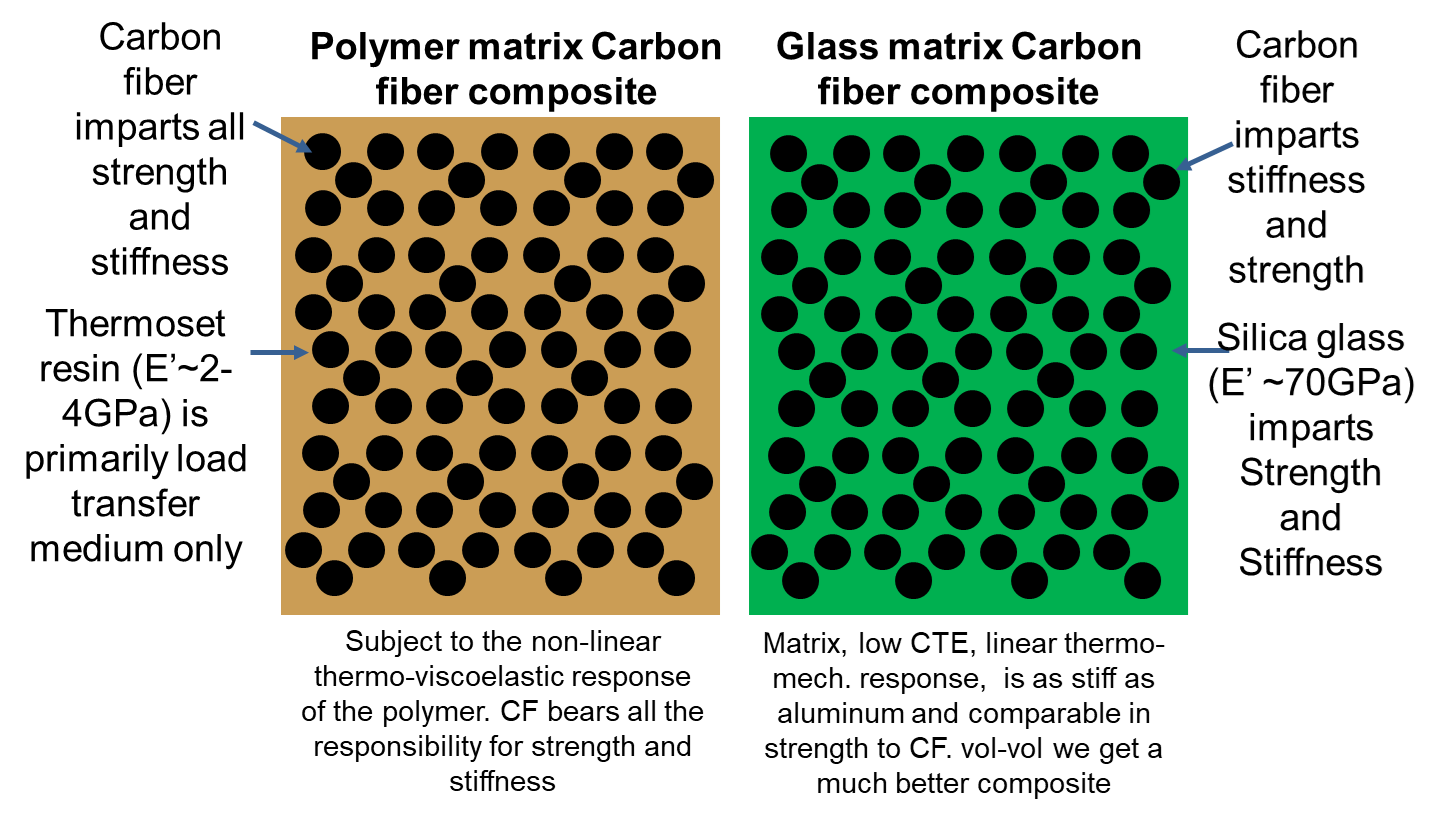Inorganic glass is a transparent functional material integrated into opto-electronic devices such as optical fibers, semiconductors, solar cells, transparent photovoltaic devices, or photonic crystals and in smart materials applications such as environmental, pharmaceutical, and medical sensors. Carbon, glass, and ceramic fiber matrix composites are multiphase materials where the reinforcing phase comprises the fibers (high strength and stiffness) and the contiguous binding phase is formed from a polymer material (either a thermoset or thermoplastic) which is orders of magnitude less stiff and strong than the fiber phase. If the “weaker” polymer material is replaced with a high strength, high stiffness, high thermal stability matrix of comparable properties to the fiber, then the resultant matrix would have both improved overall mechanical and thermal properties as compared to a fiber-polymer composite.
The approach is to combine the techniques of 3D printing aligned carbon fiber composites and melt-3D printing of glasses in a non-obvious manner to allow 3D printing (with controlled microstructure, fiber alignment, complex geometries, and advanced second order composite properties) of a new class of additively manufactured fiber-glass composites. It involves four major elements:
- Feedstock preparation- comprises a physical combination or mixture of the glass matrix material and the reinforcing fiber.
- Extrusion based deposition methods- could be direct powder melt and write, filament and melt deposition, laser sintering-based continuous fiber deposition, or powder bed fusion method.
- Toolpath and geometric design optimization- computational design optimization and toolpath planning algorithm approaches are used in the design of the component to optimize performance and physical properties.
- Annealing and post-processing- the 3D printed part may be thermally annealed to remove and reduce residual stresses.
Lewicki JP, Rodriguez JN, Zhu C, Worsley MA, Wu AS, Kanarska Y, Horn JD, Duoss EB, Ortega JM, Elmer W, Hensleigh R, Fellini RA, King MJ. 3D-Printing of Meso-structurally Ordered Carbon Fiber/Polymer Composites with Unprecedented Orthotropic Physical Properties. Sci Rep. 2017 Mar 6;7:43401 (https://doi.org/10.1038/srep43401)
The Value Proposition is improved performance at less manufacturing costs.
- 100% recyclable but can also incorporate other industrial elements to be used as raw materials.
- Outstanding thermal and chemical resistance
- Ability to tune or enhance the thermal, electrical, or mechanical properties of the composite
- High stiffness, low coefficient of thermal expansion, high strength, lightweight structural fixtures
- Thermally resilient coatings or cases
- Reentry vehicle, thermal shield, or leading-edge material for aerospace applications
- Optical mounting fixtures for high precision optics
Current stage of technology development: TRL 3 (analytical and experimental critical function and/or characteristic proof of concept).
LLNL has filed for patent protection on this invention.
U.S. Patent Application No. 2024/0383798 Systems and Methods for Additively Manufacturing High Strength and Stiffness Fiber-Reinforced Inorganic Glass Composite Structures published 11/21/24
LLNL also has a huge portfolio of 3D printing fiber-reinforced composites:
- U.S. Patent No. 9,862,140 Additive Manufacturing of Short and Mixed Fibre-Reinforced Polymer issued 1/9/2018 (IL-12962)
- U.S. Patent Application No. 2017/0015060 Additive Manufacturing Continuous Filament Carbon Fiber Epoxy Composites published 1/19/2017 (IL-12984)
- U.S. Patent No. 11,084,223 Optimal Toolpath Generation System and Method for Additively Manufactured Composite Materials issued 8/10/2021 (IL-13290)


